Rowenta irons are renowned for their powerful steam performance, precise temperature control, and innovative features like Microsteam technology․ Their ergonomic design and energy-efficient solutions make ironing easier and more efficient for all fabric types․
1․1 Overview of Rowenta Irons
Rowenta irons are highly regarded for their advanced steam technology and versatility in tackling various fabrics․ Designed with precision, they offer powerful steam performance, ensuring efficient wrinkle removal․ The Durillium soleplate, a signature feature, provides exceptional glide and durability․ Models like the Rowenta Steam Force DW9280 are praised for their ability to handle tough creases effortlessly․ Safety features such as automatic shut-off and anti-calc systems add to their reliability; User-friendly interfaces and customizable settings make them suitable for both novice and experienced users․ Regular maintenance tips, like cleaning the soleplate and descaling, are emphasized to prolong the iron’s lifespan․ With their focus on innovation and practicality, Rowenta irons are a top choice for those seeking high-quality ironing solutions․
1․2 Key Features of Rowenta Steam Irons
Rowenta steam irons are equipped with cutting-edge features designed to enhance ironing efficiency and precision․ The Microsteam technology ensures even steam distribution through numerous holes, while the powerful steam boost tackles stubborn wrinkles․ The Durillium soleplate, renowned for its durability and glide, is a standout feature, offering excellent heat distribution․ Temperature control is precise, with settings tailored for various fabrics, ensuring optimal results without damage․ Safety features like automatic shut-off add peace of mind, while the anti-calc system prevents mineral buildup, maintaining performance over time․ These features collectively make Rowenta steam irons a top choice for users seeking reliability and superior ironing performance․
1․3 Benefits of Using Rowenta Irons
Using a Rowenta iron offers numerous benefits, making it a preferred choice for many users․ The powerful steam output and precise temperature control ensure efficient wrinkle removal across various fabrics, from delicate silks to sturdy linens․ The ergonomic design reduces fatigue during extended use, while the advanced soleplate technologies, such as Durillium, provide a smooth glide and even heat distribution․ Additionally, Rowenta irons are designed with safety and durability in mind, featuring automatic shut-off and an anti-calc system to prevent mineral buildup․ These features not only extend the product’s lifespan but also ensure consistent performance․ Overall, Rowenta irons deliver professional-grade results, making ironing faster and more effective for users seeking high-quality appliances․
1․4 Importance of Reading the Rowenta Iron Manual
Reading the Rowenta iron manual is essential for optimizing performance, safety, and longevity of the appliance․ It provides detailed guidelines for proper usage, such as filling the water tank correctly, selecting the right fabric settings, and using steam functions effectively․ The manual also highlights safety precautions, like avoiding abrasive cleaners and ensuring the iron is stored upright․ By following the manual, users can prevent issues like mineral buildup, clogged steam holes, and damage to the soleplate․ Additionally, it offers troubleshooting tips for common problems, such as no steam production or water leakage, ensuring users can resolve issues quickly․ Adhering to the manual’s instructions helps maintain the iron’s efficiency and extends its lifespan, while also preventing potential safety hazards․ Ultimately, the manual serves as a comprehensive guide to unlocking the full potential of your Rowenta iron while ensuring safe and effective operation․
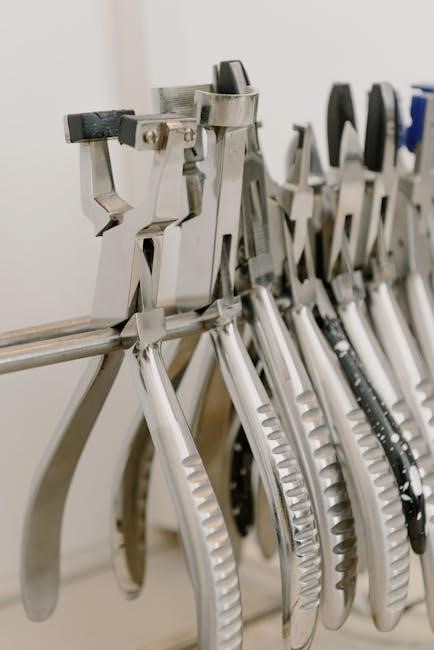
Understanding the Rowenta Iron’s Features
Rowenta irons feature advanced soleplates like Durillium for durability and smooth gliding, while Microsteam technology ensures even steam distribution․ They also include temperature controls, steam boost functions, and safety features like auto-shutoff for efficient and secure ironing․

2․1 Types of Soleplates (Durillium, Stainless, Autoclean)
Rowenta irons offer three distinct types of soleplates, each designed for specific needs․ The Durillium soleplate is known for its exceptional durability and even heat distribution, making it ideal for heavy-duty ironing․ The stainless steel soleplate is resistant to scratches, easy to clean, and glides smoothly over fabrics․ For added convenience, the Autoclean soleplate features a non-stick coating and self-cleaning technology, reducing maintenance efforts․ Each type ensures efficient ironing performance while protecting delicate fabrics․ Proper care, such as regular cleaning and avoiding abrasive materials, extends the life of the soleplate․ Users can choose the soleplate that best matches their ironing habits and fabric types, ensuring optimal results for every garment․
2․2 Temperature Control and Fabric Settings
Rowenta irons feature precise temperature control systems, allowing users to select the perfect heat setting for various fabrics․ The LED screen displays options like NYLON, SILK, WOOL, COTTON, and LINEN, ensuring accurate temperature adjustments․ This prevents damage to delicate materials and optimizes ironing efficiency․ The thermostat light indicates when the desired temperature is reached, maintaining consistent heat for reliable results․ By matching fabric types with the correct settings, users achieve professional-grade ironing․ Regular maintenance, such as cleaning the soleplate, ensures the iron continues to perform effectively․ The temperature control system is designed to adapt to different fabrics, making it easy to iron a variety of garments with confidence․ Proper use of these settings extends the life of both the iron and the fabrics being ironed․ Always refer to the manual for specific recommendations on fabric and temperature pairings to achieve the best results․
2․3 Steam Function and Microsteam Technology
Rowenta irons stand out for their advanced steam function and Microsteam technology, designed to deliver powerful and consistent steam distribution․ The Microsteam soleplate features numerous tiny holes, ensuring even steam release for efficient wrinkle removal․ The steam boost function provides an extra burst of steam for tough creases, while the LED screen indicates when the iron is ready for steam use․ For optimal results, the steam function should be used in conjunction with the correct fabric settings, such as COTTON or LINEN modes․ It’s important to avoid overusing the steam trigger and to wait a few seconds between activations to maintain performance․ The steam function is only active when the iron is properly heated, as indicated by the LED display․ This technology ensures a professional-grade ironing experience, making it easier to smooth out fabrics and achieve crisp results․ Regular maintenance, like cleaning the steam holes, helps preserve the functionality of this feature․
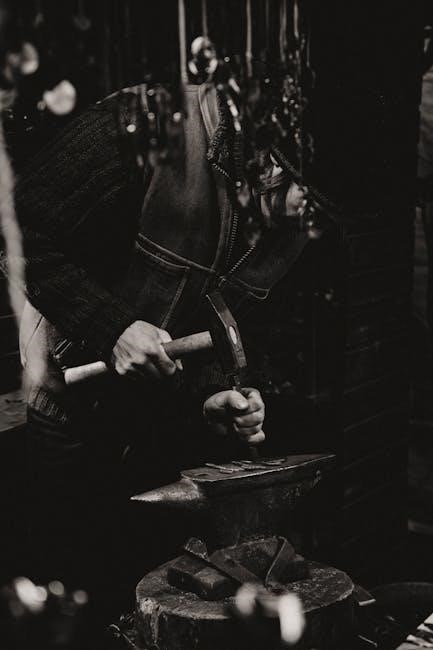
2․4 Safety Features (Automatic Shut-Off, Anti-Calc System)
Rowenta irons are equipped with advanced safety features to ensure secure and worry-free ironing․ The Automatic Shut-Off function is a key safety mechanism that turns off the iron after a period of inactivity, preventing overheating and potential fires․ This feature is activated if the iron remains stationary for more than 8 minutes on its heel or 30 seconds when placed flat․ To restart, simply move the iron gently until the light stops flashing․ Additionally, the Anti-Calc System helps prevent mineral buildup in the steam function, maintaining performance and longevity․ Regular descaling is recommended to remove calcium deposits, which can be done using the Calc Clean program․ These features not only enhance safety but also protect the iron from damage, ensuring optimal performance over time․ Always unplug the iron before cleaning or filling the water tank for added safety․ These safety features make Rowenta irons a reliable choice for everyday use․
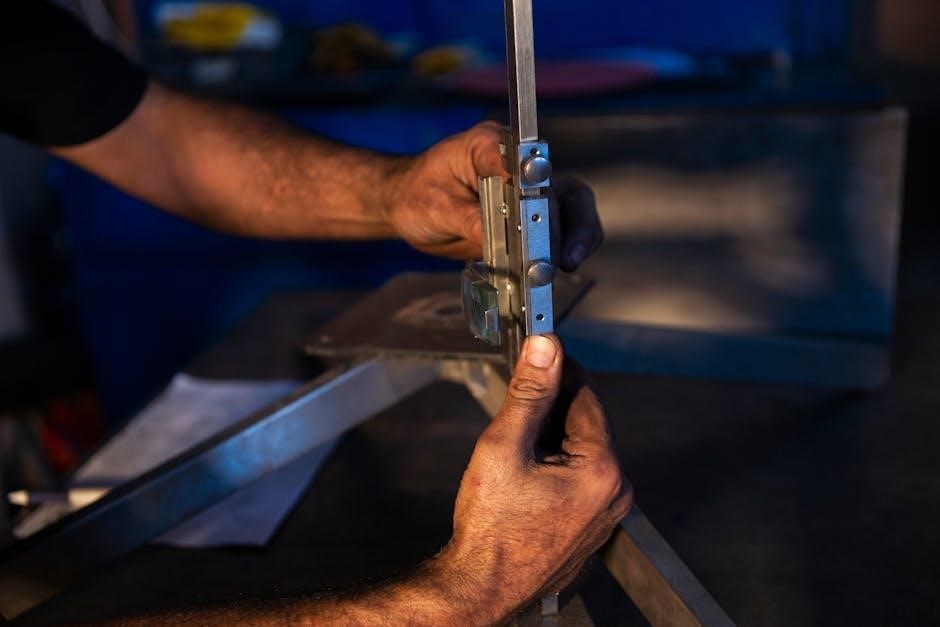
Operating Your Rowenta Iron
Operating your Rowenta iron involves filling the water tank, selecting the right temperature for fabrics, and using steam or dry modes․ Vertical steaming is perfect for hanging garments, ensuring efficient ironing․
3․1 Filling the Water Tank Properly
Filling the water tank of your Rowenta iron is essential for optimal steam performance․ Always ensure the iron is unplugged before filling to avoid accidents․ Locate the water tank, typically positioned on the side or top of the iron, and remove the lid․ Use distilled or tap water, avoiding chemicals or starch products, as these can damage the iron․ Fill the tank to the maximum level indicated in the manual to prevent overfilling, which can cause leaks․ Replace the lid securely to ensure proper steam function․ If the tank has a specific measuring cup, use it for accurate filling․ For dry ironing, set the steam control to the “Dry” position before filling․ After filling, plug in the iron and allow it to heat up before use․ Regularly cleaning the tank and descaling the iron will maintain its efficiency and longevity․ Always refer to the user manual for model-specific instructions․
3․2 Selecting the Right Temperature for Different Fabrics
Selecting the correct temperature for your fabrics is crucial to avoid damage and ensure effective ironing․ Rowenta irons feature a temperature control dial or buttons that allow you to choose settings based on fabric type․ For delicate fabrics like silk and nylon, use lower temperatures to prevent scorching․ Synthetic fibers such as polyester can withstand medium heat, while cotton and linen require higher temperatures to remove stubborn wrinkles․ Always refer to the fabric care label for specific guidance․ Some Rowenta models include an LED screen that automatically adjusts the temperature based on the selected fabric type, ensuring precise control․ It’s important to start with lower temperatures for mixed-fiber fabrics, as the iron takes longer to cool down than to heat up․ Adjusting the temperature correctly ensures optimal ironing results and prolongs the life of your garments․ Proper temperature selection also enhances steam efficiency, making the ironing process smoother and more effective․
3․3 Using Steam and Dry Ironing Modes
Rowenta irons offer both steam and dry ironing modes, allowing you to tailor your ironing experience to different fabrics and needs․ For steam mode, ensure the water tank is filled to the recommended level and the steam function is activated․ This mode is ideal for removing stubborn wrinkles from fabrics like cotton and linen․ For delicate fabrics, switch to dry mode by disabling the steam function, which prevents scorching and damage․ Some models allow vertical steaming for hanging garments, perfect for refreshing clothes without an ironing board․ Always clean the soleplate regularly to maintain steam efficiency and prevent mineral buildup․ Proper use of these modes ensures optimal results and extends the lifespan of your iron․ Refer to the manual for specific guidelines on selecting the right mode for your fabric type․
3․4 Vertical Steaming for Hanging Garments
Vertical steaming with your Rowenta iron is a convenient way to remove wrinkles from hanging garments like dresses, suits, and curtains․ To use this feature, select the appropriate fabric mode, such as cotton or linen, and ensure the iron is hot․ Hold the garment steady with one hand and use the other to press the steam trigger intermittently in an up-and-down motion․ This method softens fibers and smooths wrinkles without the need for an ironing board․ For optimal results, avoid steaming too intensively and wait a few seconds between each trigger press․ Never steam garments while they are being worn, as the steam can cause burns․ After use, turn off the steam function and allow the iron to cool before storing it․ Regularly clean the steam outlet holes to ensure consistent performance and prevent mineral buildup․
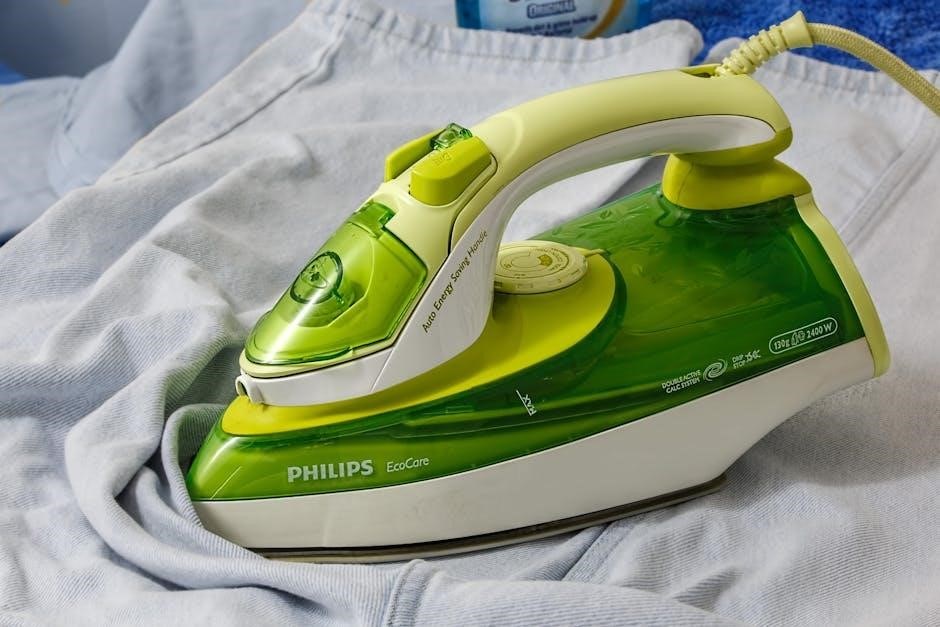
Maintenance and Cleaning Tips
Regularly clean the soleplate with a damp cloth to prevent residue buildup; Use a soft sponge for stainless steel or autoclean models․ Descaling prevents mineral deposits and ensures optimal steam performance․ Always store the iron upright and empty excess water to avoid corrosion and staining․ For tough stains, use a cleaning stick designed for your soleplate type․ Avoid harsh chemicals or abrasive materials that could damage the surface․ Check the water tank for sediment and refill as needed․ Proper maintenance extends the life of your Rowenta iron and maintains its efficiency․ Clean the steam outlets with a toothbrush to ensure consistent steam flow․ Regularly inspect and replace worn parts, like the anti-calc cartridge, to maintain performance․ Always unplug the iron before cleaning or storing it․ For detailed instructions, refer to your Rowenta iron manual․ Clean the ironing board cover regularly to prevent fabric residue buildup․ Use distilled water to minimize mineral deposits in the water tank․ If the iron has not been used for an extended period, drain the water tank completely before storing․ For models with a removable water tank, rinse it with warm water and let it dry․ Avoid leaving the iron in humid environments to prevent rust․ If you notice a decrease in steam output, clean the steam holes with a needle or small pin․ For stubborn stains on the soleplate, mix equal parts water and white vinegar on the warm soleplate, then wipe clean․ Always follow the manufacturer’s recommendations for cleaning products and maintenance routines․ Regular descaling is crucial in areas with hard water to prevent limescale buildup․ If your iron has an auto-clean function, use it periodically to maintain performance․ Store the iron in a cool, dry place away from direct sunlight․ Clean the cord and exterior with a damp cloth to keep your iron looking new․ Replace the ironing board cover if it becomes worn or damaged to ensure proper steam distribution․ For persistent odor or smoke, clean the soleplate thoroughly and ensure it is dry before storing․ If you notice water leaking, check the tank for cracks and ensure it is properly aligned․ Clean the steam trigger and handle regularly to prevent mineral deposits from affecting performance․ Always refer to the user manual for specific maintenance instructions tailored to your Rowenta iron model․ By following these tips, you can keep your Rowenta iron in excellent condition and ensure optimal performance for years to come․
4․1 Cleaning the Soleplate Regularly
Cleaning the soleplate of your Rowenta iron is essential to maintain its performance and prevent residue buildup․ For Durillium soleplates, use a damp, non-metallic sponge while the iron is warm․ For stainless steel soleplates, clean with a damp cloth when cool․ Autoclean soleplates require a soft, damp cloth to avoid damaging the coating․ Avoid using abrasive materials or iron cleaners, as they can harm the surface․ For tough stains, use a cleaning stick designed for your soleplate type․ Regular cleaning ensures smooth gliding and even heat distribution․ After cleaning, wipe the soleplate dry to prevent water spots․ Always unplug the iron before cleaning․ If fibers are stuck in the steam holes, use a toothbrush to gently remove them․ Cleaning the soleplate regularly extends the life of your iron and ensures optimal results․ Refer to your Rowenta iron manual for specific cleaning recommendations tailored to your model․
4․2 Descaling Your Rowenta Iron
Descaling your Rowenta iron is crucial to remove mineral buildup from hard water, which can clog steam holes and reduce performance․ Use distilled water and a descaling solution recommended in the manual․ Avoid chemical agents, as they may damage the iron․ For most models, activate the Calc Clean program: unplug the iron, fill the water tank, plug it back in, and press the MODE and steam trigger simultaneously for 3 seconds․ The program runs for 4-6 minutes, flushing out scale․ After descaling, rinse the tank and run steam cycles with fresh water to remove any residue․ Regular descaling ensures optimal steam flow and prevents damage․ If your model lacks this feature, manually descale by filling the tank with a descaling solution, letting it sit, then rinsing thoroughly․ Always refer to your Rowenta iron manual for specific instructions tailored to your model to maintain its efficiency and longevity․
4․3 Emptying and Storing Water in the Tank
Properly emptying and storing water in your Rowenta iron’s tank is essential to prevent mineral buildup and bacterial growth․ After each use, unplug the iron and let it cool․ Pour out any remaining water from the tank, especially if the iron will be stored for an extended period․ For storage, ensure the tank is nearly empty to avoid water evaporation and residue formation․ If storing horizontally, check that the tank is empty and the steam function is turned off to prevent leaks․ For models with removable tanks, detach and clean them separately․ Always store the iron upright to maintain balance and prevent accidental spills․ Regularly cleaning the tank with a soft cloth ensures hygiene and prevents scale buildup․ Follow these steps to keep your Rowenta iron in optimal condition and ready for future use․
4․4 Regular Maintenance Checks
Regular maintenance checks are crucial to ensure your Rowenta iron performs optimally and lasts longer․ Start by inspecting the power cord for any signs of damage or fraying․ Always unplug the iron before performing any maintenance tasks․ Check the soleplate for residue or stains and clean it with a damp, non-abrasive sponge while it’s still warm․ Inspect the steam holes for blockages and ensure they are free from debris․ For models with an autoclean soleplate, use a soft cloth to avoid damaging the coating․ Regularly descale your iron to prevent mineral buildup, especially if you live in an area with hard water․ Store the iron upright and ensure the water tank is nearly empty to prevent leakage․ Finally, refer to your user manual for specific maintenance recommendations tailored to your Rowenta iron model․ Consistent care will keep your iron in excellent working condition and ensure consistent results․

Troubleshooting Common Issues
Common issues with Rowenta irons include no steam production, water leaks, or shiny marks on fabrics․ Check water levels, ensure proper temperature settings, and clean the soleplate regularly․ For auto-off issues, move the iron to reactivate it․
5․1 No Steam Production: Possible Causes and Solutions
No steam production in your Rowenta iron can be due to low water levels, incorrect temperature settings, or mineral buildup․ Ensure the water tank is filled to the recommended level and the fabric mode is set correctly․ If the issue persists, descale the iron to remove mineral deposits and clean the soleplate․ Always use distilled water to prevent scaling․ If the steam trigger is not functioning, check for blockages in the steam holes․ Regular maintenance, like cleaning the soleplate with a damp sponge, can prevent such issues․ Refer to the manual for specific descaling instructions․ If the problem continues, contact Rowenta customer support for assistance․ Proper care ensures consistent steam performance and prolongs the iron’s lifespan․
5․2 Water Leaking from the Iron: How to Fix It
Water leaking from your Rowenta iron is often caused by overfilling the water tank or improper storage․ Always ensure the water level does not exceed the maximum mark․ If stored horizontally, check that the tank is empty and the steam setting is off․ After ironing, empty excess water and store the iron upright․ If leakage occurs during use, verify that the steam function is activated correctly and the soleplate is clean․ Mineral buildup can also cause leaks, so regular descaling is essential․ For persistent issues, clean the steam holes with a needle or soft brush․ Avoid using tap water with high mineral content to prevent scaling․ If the problem persists, refer to the manual or contact Rowenta support for further assistance․ Proper maintenance ensures optimal performance and prevents water leakage․
5․3 Shiny Marks on Fabrics: Prevention and Removal
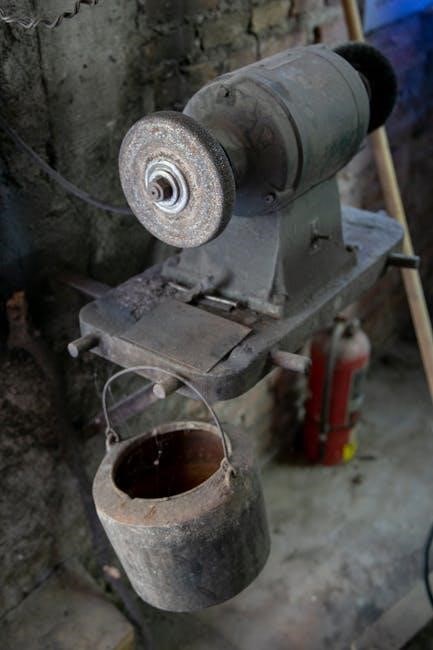
Shiny marks on fabrics can occur due to excessive heat, steam, or improper ironing techniques․ To prevent this, always iron dark or delicate fabrics inside out and use the correct temperature setting for the fabric type․ Avoid using starch or fabric finishes before ironing, as they can leave residue․ If shiny marks appear, dampen the fabric with a clean cloth and gently iron it without steam․ For stubborn marks, mix equal parts water and white vinegar on a soft cloth and blot the area lightly․ Never rub, as this can damage the fabric further․ Regularly cleaning the soleplate and ensuring proper steam function can also help prevent marks․ If the issue persists, refer to your Rowenta iron manual for specific guidance on fabric care and iron maintenance․
5․4 Auto-Off Function: Understanding and Managing
The auto-off function is a safety feature designed to turn off the iron after a period of inactivity․ This feature activates if the iron remains stationary for 8 minutes on its heel or 30 seconds when laid flat․ If the auto-off light blinks, gently move the iron to reactivate it․ Ensure the iron is placed on a stable surface and avoid leaving it unattended․ If the auto-off function engages frequently, check if the iron is in a stationary position or if the power source is stable․ To restart, simply move the iron gently until the light stops flashing․ This feature is essential for preventing overheating and ensuring safety․ Regularly cleaning the iron and maintaining proper water levels can also help prevent unexpected auto-off activation․ Always refer to your Rowenta iron manual for specific instructions on managing this feature effectively․
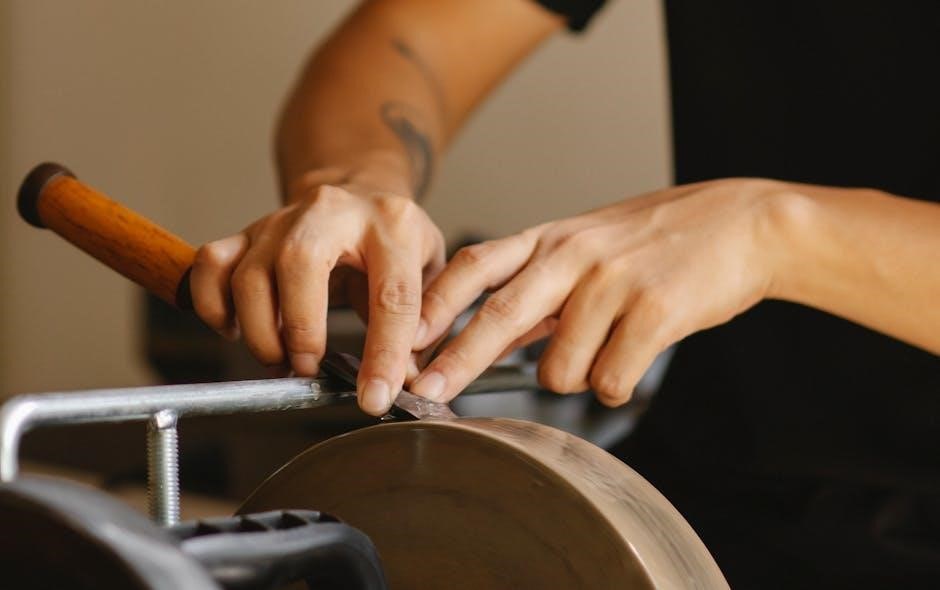
Safety Precautions and Tips
Safety is crucial when using your Rowenta iron․ Never leave it unattended, avoid water contact, and ensure the power cord is undamaged․ Keep it out of children’s and pets’ reach for optimal protection․
6․1 Handling the Iron Safely
Always handle your Rowenta iron with care to ensure safety․ Avoid touching the soleplate and steam holes, as they can become extremely hot during use․ Use the heat-resistant handle or soleplate to carry the iron, preventing burns․ Keep the iron out of reach of children and pets to avoid accidents․ Never leave the iron unattended or on a flammable surface․ Ensure the power cord is not damaged or tangled, as this can cause electrical hazards․ When not in use, store the iron upright in a cool, dry place․ Always unplug the iron before filling the water tank or cleaning it to prevent any risk of electric shock․ By following these precautions, you can safely operate and maintain your Rowenta iron for optimal performance and longevity․
6․2 Storing the Iron Properly
Proper storage of your Rowenta iron is essential to maintain its performance and longevity․ Always unplug the iron and allow it to cool completely before storing․ Remove any excess water from the tank to prevent mineral buildup and bacterial growth․ Store the iron in an upright position to avoid leakage and ensure the soleplate remains clean․ Place it in a dry, cool environment away from direct sunlight to prevent damage to the finish․ Avoid storing the iron in a humid area or near flammable materials․ For added protection, consider using a heat-resistant storage bag or cover․ Regularly cleaning the soleplate before storage can also prevent residue from affecting future use․ By following these steps, you can ensure your Rowenta iron remains in excellent condition and ready for its next use․
6․3 Avoiding Damage to the Iron and Fabrics
To prevent damage to your Rowenta iron and fabrics, always use distilled or tap water, avoiding chemical additives or starch products․ Clean the soleplate regularly with a damp sponge or soft cloth to remove residue and ensure smooth gliding․ Never iron over buttons, zippers, or abrasive items, as they can scratch the soleplate․ For fabrics, select the appropriate temperature setting to avoid scorching or discoloration․ Store the iron in an upright position and use a heat-resistant storage bag to protect it from dust․ Avoid leaving the iron unattended while hot, especially near children or pets․ Before first use, ensure the iron is clean and free from manufacturing residues․ Regularly check for damage to the power cord or soleplate and contact Rowenta support if issues arise․ Proper care extends the life of your iron and ensures safe, effective ironing for all fabric types․
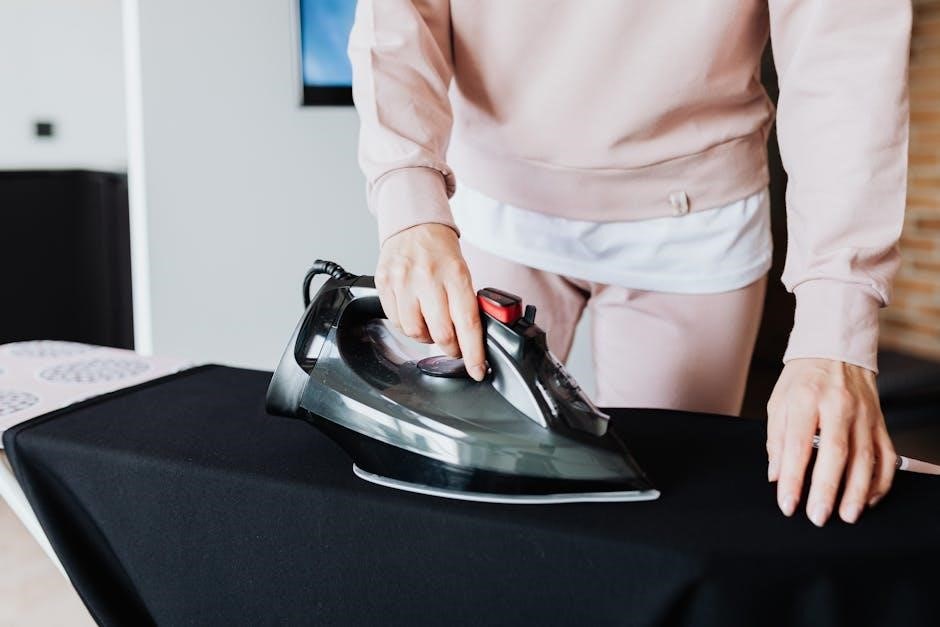
6․4 Setting Up the Ironing Board Correctly
Setting up your ironing board correctly is essential for safe and effective ironing; Choose a sturdy, height-adjustable board that fits your height to avoid strain․ Ensure the board is steady and robust to support the iron and fabrics without wobbling․ The ironing board should have a perforated surface to allow steam to pass through, softening fabrics and making ironing easier․ Use a high-quality cover designed for steam ironing, as it helps distribute heat evenly and prevents water spots․ Place the board on a heat-resistant surface and keep it away from flammable materials․ Always ensure the iron is placed on its heel rest or base when not in use․ For optimal results, consult your Rowenta manual for specific board recommendations tailored to your iron model․ Proper setup ensures a safer and more efficient ironing experience․